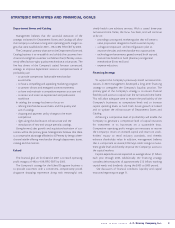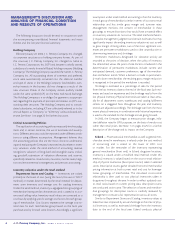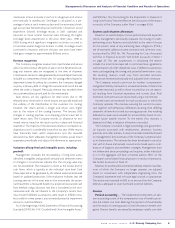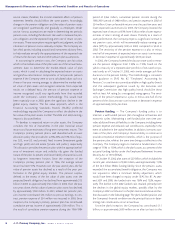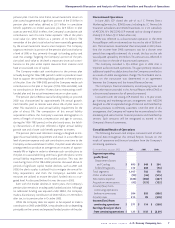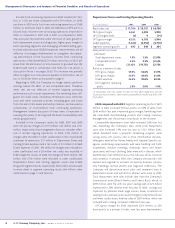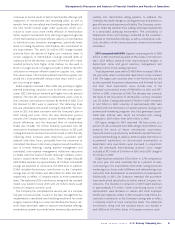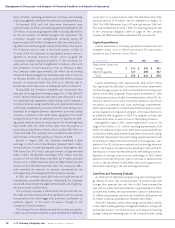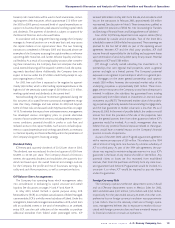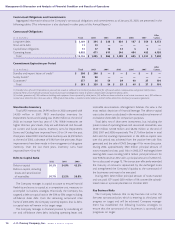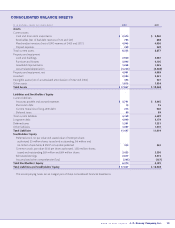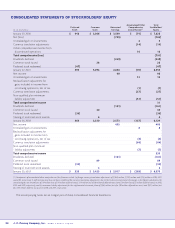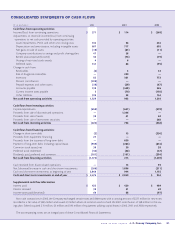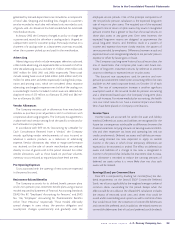JCPenney 2002 Annual Report Download - page 16
Download and view the complete annual report
Please find page 16 of the 2002 JCPenney annual report below. You can navigate through the pages in the report by either clicking on the pages listed below, or by using the keyword search tool below to find specific information within the annual report.
2002 annual report J. C. Penney Company, Inc. 13
Management’s Discussion and Analysis of Financial Condition and Results of Operations
forward, cash investments will be used to fund several areas, includ-
ing long-term debt maturities, which approximate $1.2 billion over
the 2003 to 2005 period, increased levels of capital expenditures to
support its business objectives, peak seasonal working capital needs
and dividends. The payment of dividends is subject to approval by
the Board of Directors and is discussed below.
In accordance with its long-term financing strategy, the Company
manages its financial position on a multi-year basis and may access
the capital markets on an opportunistic basis. The two financing
transactions completed in February 2003 and discussed above are
examples of the Company accessing the capital markets to refinance
upcoming debt maturities, and further enhance liquidity and finan-
cial flexibility. As a result of its strong liquidity position after complet-
ing these transactions, the Company does not anticipate that addi-
tional external financing will be required in 2003 to fund the operat-
ing needs described above. Additionally, the Company does not
expect to borrow under the $1.5 billion credit facility except to sup-
port ongoing letters of credit.
For 2003, free cash flow is expected to be negative by approxi-
mately $250 million, which is after funding capital expenditures at the
high end of the previously stated range of $0.9 billion to $1.1 billion,
working capital needs and dividends at the current level.
Notwithstanding the positive momentum generated during the
first two years of its stated five-year turnaround, management recog-
nizes that many challenges and risks remain for 2003 and beyond.
Some of these risks are discussed under Key Business Risks on pages
14-15. To minimize the impact from unforeseen events, management
has developed various contingency plans to provide alternative
courses of action under several scenarios, including deteriorating eco-
nomic conditions, potential shortfalls in profits or cash flow, and
reduced access to the capital markets. Such actions include adjust-
ments to capital expenditure and working capital levels, as necessary,
to maintain liquidity and financial flexibility within the parameters of
the Company’s long-term financing strategy.
Dividend Policy
JCPenney paid quarterly dividends of $0.125 per share in 2002.
The dividend rate was reduced for the third quarter of 2000 from
$0.2875 to $0.125 per share. The Company’s Board of Directors
reviews the quarterly dividend and establishes the quarterly divi-
dend rate based upon the overall financial and strategic outlook
for the Company, the profile and mix of businesses, earnings, liq-
uidity and cash flow projections, as well as competitive factors.
Off-Balance Sheet Arrangements
The Company has operating leases which management takes
into consideration in evaluating its capital structure and overall
liquidity. See discussions on pages 14 and 41 and Note 14.
In May 2001, Eckerd formed a special purpose entity, ECR
Receivables, Inc. (ECR), to complete a securitization of Eckerd managed
care receivables. ECR is a wholly owned subsidiary of Eckerd. Under this
arrangement, Eckerd sells managed care receivables to ECR, which then
sells an undivided interest in the pool of receivables to an unrelated
entity. ECR uses the cash collections of the receivables to purchase
additional receivables from Eckerd under prearranged terms. JCP
received $200 million in May 2001 from the sale, and recorded a small
loss on the transaction. In February 2003, approximately $50 million
was received. See discussion in Note 5. These transactions qualified as
sales under the provisions of SFAS No. 140, “Accounting for Transfers
and Servicing of Financial Assets and Extinguishments of Liabilities.”
Four of the 10 JCPenney department store support centers (SSCs)
are operated by outside service providers. Two of the three SSCs
scheduled to open in 2003 will also be outsourced. These openings are
planned for the first half of 2003. As part of the operating service
agreement between JCP and the third party providers, JCP shall
assume financial responsibility for the building and equipment leases
upon termination of services by either party for any reason. Potential
obligations of JCP total $185 million.
JCP, through a wholly owned subsidiary, has investments in 15
partnerships that own regional mall properties, seven as general
partner and eight as a limited partner. The Company’s potential
exposure to risk is greater in partnerships in which it is a general part-
ner. Mortgages on the seven general partnerships total approxi-
mately $350 million; however, the estimated market value of the
underlying properties is approximately $587 million. These mort-
gages are non-recourse to the Company, so any financial exposure is
minimal. In addition, the subsidiary has guaranteed loans totaling
approximately $43 million related to investments in one real estate
investment trust (REIT). The estimated market value of the underly-
ing properties significantly exceeds the outstanding mortgage loans,
and the loan guarantee to market value ratio is less than 3% as of
January 25, 2003. In the event of possible default, the creditors would
recover first from the proceeds of the sale of the properties, next
from the general partner, then from other guarantors before JCP’s
guarantee would be invoked. As a result, management does not
believe that any potential financial exposure related to these guar-
antees would have a material impact on the Company’s financial
position or results of operations.
As part of the 2001 DMS sale, JCP signed a guarantee agreement
with a maximum exposure of $20 million. This relates to the 1994
sale of a block of long-term care business by a former subsidiary of
JCP to a third party. As part of the 1994 sale agreement, the pur-
chaser was required to maintain adequate reserves in a trust. JCP’s
guarantee is the lesser of any reserve shortfall or $20 million. Any
potential claims or losses are first recovered from established
reserves, then from the purchaser and finally from any state insur-
ance guarantee fund before JCP’s guarantee would be invoked. It is
uncertain if, or when, JCP would be required to pay any claims
under this guarantee.
Foreign Currency Risk
The Company operates 54 Renner department stores in Brazil
and six JCPenney department stores in Mexico. Sales for 2002,
2001 and 2000 were $321 million, $316 million and $353 million,
respectively. For the year ended January 25, 2003, the other com-
prehensive loss on foreign currency translation was approximate-
ly $64 million. Due to the relatively small size of foreign opera-
tions, management believes that its exposure to market risk asso-
ciated with foreign currencies does not have a material impact on
its financial condition or results of operations.


